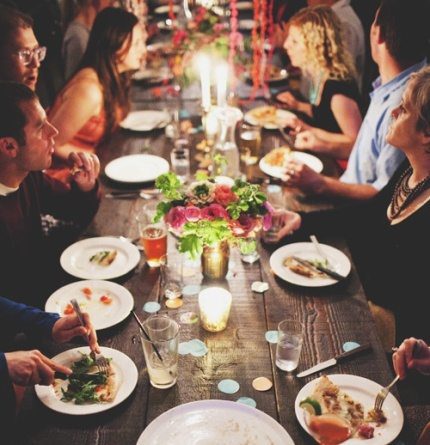You know the routine; you’ve spent months looking after your crops, cared for them, and watched over them carefully. After all your hard work, on the day you harvest you’re unable to sell your gorgeous harvest at the farmers market because it rained, it’s a holiday, or just bad luck. Perk up! Turn that unmoved abundance into a surplus harvest marketing opportunity to experiment with exciting new approaches to customer direct business models that are a rising trend across the nation.
Harvest Marketing on Wheels
Mobile farm markets are riding high on the heels of the white-hot food truck trend. It’s a new take on the old fashioned neighborhood ice cream truck. Instead of selling ice cream to screaming kids running after a lighthearted tune coming from a colorful van, you are selling your locally grown food to enthusiastic urban hipsters. Calling them to your mobile market with Twitter, FourSquare, geo location apps like Google Latitude, or blasting obscure indie techno music from your speakers in dense urban neighborhoods.
Pick your vehicle for your mobile market wisely, just remember that character matters. Think converted airstream trailers, ironic postal jeeps, or your grandfather’s old pickup. For some great examples, be sure to check out Lomo Market in Raleigh-Durham, NC or the Honeybee Mobile Market. Cost: About the price of a small row tractor.
 Mobile markets created from trailers, trucks, or vans are great for when you have planned stops, and a bit of cash. Perhaps you need something cheaper, and easier to do without much planning required. Consider a slower, more approachable alternative: your bike pulling a trailer full of produce. Turning your bike into a mobile produce stand offers a charming, approachable venue to sell to urban dwellers as they stroll through their neighborhoods and downtown restaurant districts.
Mobile markets created from trailers, trucks, or vans are great for when you have planned stops, and a bit of cash. Perhaps you need something cheaper, and easier to do without much planning required. Consider a slower, more approachable alternative: your bike pulling a trailer full of produce. Turning your bike into a mobile produce stand offers a charming, approachable venue to sell to urban dwellers as they stroll through their neighborhoods and downtown restaurant districts.
The slow speed of a bike-borne market makes it easy for people to stop and buy, keeping you from having to stop for extended periods, and having to get permits or ask permission from establishments. There are a few farmers experiencing great success with this technique. If you’d like to try it out yourself the “Mattapan Mobile Farm Stand” is a great design – view it here. Cost: A new implement for your tractor.
Harvest Marketing by the Plate
Celebrate your unsold surplus as an occasion by cooking a farm dinner at your farm from your surplus crops. Agritourism has proven a very profitable venture for many farms. There is actually more money in selling the small farming experience than the products you’ve produced. Create a “dinner club,” and spread the word through your Twitter, Facebook, and Pinterest accounts. Contact a couple local food bloggers, and invite them to a couple in exchange for posting about the “privileged opportunity” to attend your farm surplus dinner.
 And if your ‘farm’ is in an urban basement, or small backyard greenhouse? Improvise! People love the unique and unusual. Its not just where you’re growing, but what you’re growing that they’re after. Follow the recipe for success that other’s have done well with.
And if your ‘farm’ is in an urban basement, or small backyard greenhouse? Improvise! People love the unique and unusual. Its not just where you’re growing, but what you’re growing that they’re after. Follow the recipe for success that other’s have done well with.
Don’t have enough diversity in your surplus to create an entire dinner? Create what you can, and make it a potluck – where the cost is half price if the attendees bring a dish. Lots of candles, white linen covered picnic tables, and ample mason jars are sure to create the perfect mood. Some great examples of farms using on-farm or local pub dinner clubs effectively are the Rogowski Farm, and the Land’s Sake Supper Club. Also check out dinner clubs that travel to many dinners like the Highlands Dinner Club, and City Provisions. Cost: Free meal for friends in exchange for labor and supplies.
Of course, the best option is to eliminate next week’s surplus!
Creative Product Packaging
Surplus produce is often surplus because your customers are not familiar with your crop’s use, and preparation, or just simply haven’t been inspired to use it. Give them some suggestions by grouping the produce together in “meal packs”. For example, create a stir fry kit by placing your Asian greens with a recipe, and some bulk seasonings together. There are many online resources that allow you to type in your ingredients, and an ideal recipe will be generated from your input – my favorite is Gojee.com. This makes it easy to find a recipe and create soul food meal kits, salad kits, kids lunch kits, tapas kits, ethnic meal kits, or create special diet kits like gluten-free, diabetic, or paleolithic. Cost: Extra labor and sleek packaging.
The prices for these new economic models are within reach, and the most ambitious are often no more expensive than a piece of production equipment. Instead of increasing your production this year by 10% with new equipment, consider receiving twice the price you’d normally receive with an investment into unique approaches to consumer direct marketing.
Of course, there’s always the carryout food trailer option for harvest marketing too, cooked in the parking space next to your urban freight container farm. That’s what this article’s author Ben Greene is into these days at The Farmery in Durham, North Carolina.